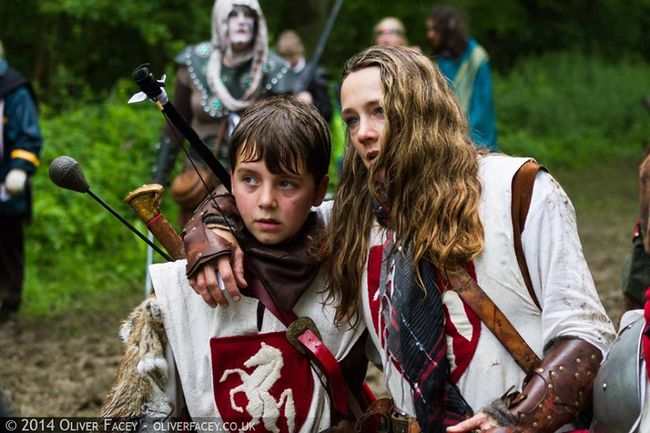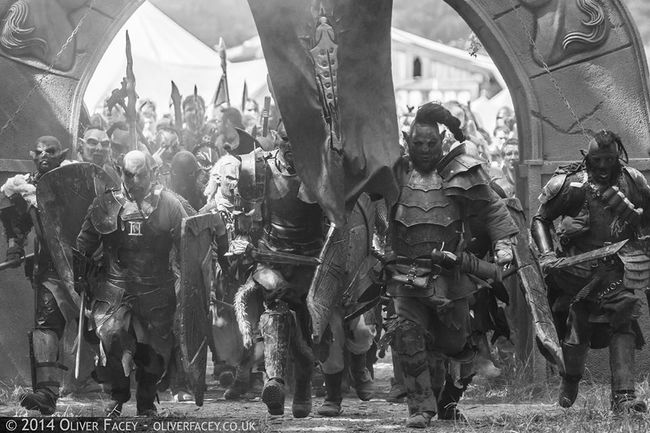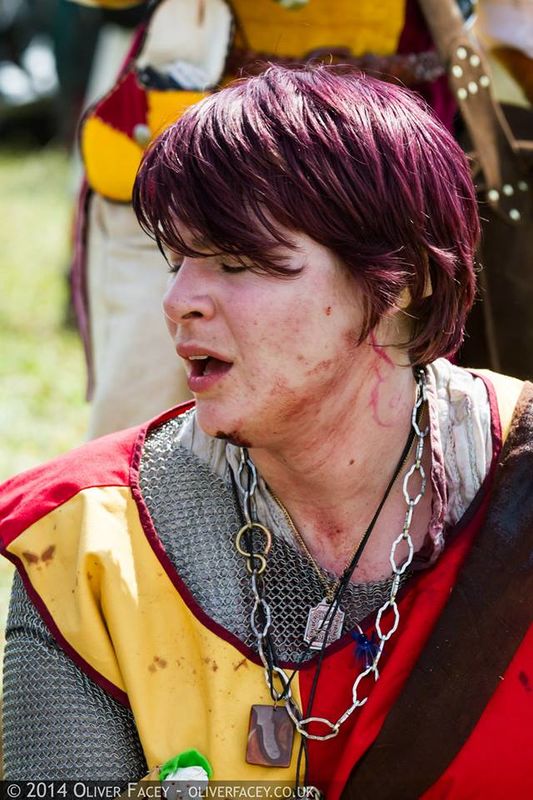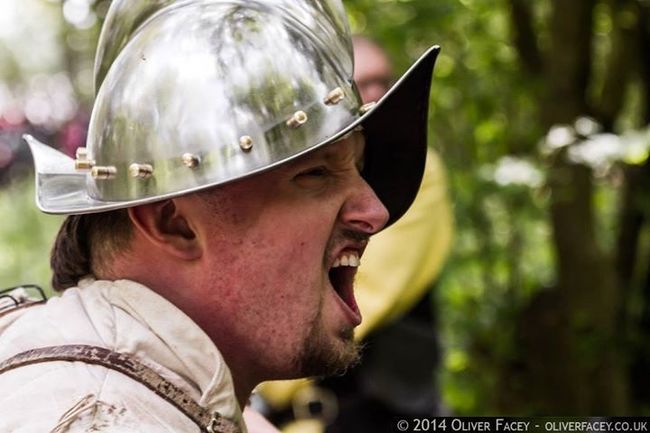378YE Autumn Equinox winds of war
Overview
Golden Summer fades slowly into brazen Autumn. It is one of the wettest Summers in living memory, and as the rain falls and the waters flow, so the blood flows also. On the western front, all is quiet - perhaps too quiet - but from Segura to Upwold there are no large-scale engagements, just occasional skirmishes between human and orc warbands making speculative raids into each others' territories.
In the north, in Sermersuaq, the Battle of the Stonefields sees the slow advance of the Thule as they inexorably claim more and more ground in the Silver Peaks despite strong Imperial opposition. On the far side of the Empire, in Karsk the Varushkan defenders make sinister alliances in an attempt to defend their newly liberated territory from the Thule barbarians - but there also they are slowly being forced back. It seems almost inevitable that without reinforcements, Karsk will be lost to the Empire again before the end of the year.
It is not all bad news, however. The Imperial forces defending Holberg city against the Druj face a sea of orcs supported by immense siege engines and terrible beasts but walls of Holfried have never been breached by enemy forces ... and the barbarians are forced to retreat from the walls after a fierce and protracted siege.
Finally, along the western shores of the Bay of Catazar, a supernaturally potent Tempest rages for several months, smashing the coast of Spiral and devastating the Grendel-held port of Apulus. Garbled eyewitness reports suggest the quayside there is reduced to splinters, damaging the ability of the sea-faring barbarians to funnel supplies their forces there in the shadow of the Black Plateau.
Victory in Holberg, then; and while the campaigns in Sermersuaq and Karsk are not going well, no territory has been lost. Autumn is a season for reaping what has been sown - and it remains to be seen precisely what is going to grow from the rocky ground of a year of warfare.
Blood on the Stonefields
As the days slowly lengthen toward Autumn, the skies are clear and bright, but at night the glittering sea of stars brings with it a bone numbing cold that promises a long winter to come. The Silver Peaks in north-eastern Sermersuaq echo with the thunder of war. The Green Shield and the Fist of the Mountain - already engaged in holding back the Thule advance through the Silver Peaks - are joined by the stoic Winter Sun (accompanied by a thousand silent husks torn from the battlefields of Holberg) and the fleet-footed Freeborn of the Fire of the South. They face the forces of the Thule in the foothills below the peaks.
Having begun to secure the upper passes, the Thule now focus their attention to the Stonefields themselves. The attempt by the Thule to claim the Stonefield Ice Caves was turned back by the swift action of the Empire's heroes; now they seek to claim the broken plains scattered with rich deposits of tempest jade and the rocky sanctuaries where crystal mana pools.
The Thule fight under the banner of the white hound - fight to the pounding of drums with a savage abandon that matches the cold fury of the Winterfolk, the disciplined might of the Imperial orcs and the passion of the Fires of the South. Their armies are wound around with sorcery. Their leaders seem preternaturally astute, predicting the moves of their opponents with uncanny accuracy, while the savage hunters of the Ice Shard Banner move through the foothills and broken terrain like ghosts, striking deep into East Floes and Suaq Fount. More dramatically, the warlocks fighting under the Lightning banner twist the weather itself to their command, sending blizzards of unseasonal snow to bog down the defenders and leave them vulnerable to deadly ambush.
The Thule sorcery does not go unanswered; Imperial magic causes the snowfields of Sermersuaq to glitter in the summer sun. Potent healing magic drawn from the Spring realm means that any wound short of a killing blow heals almost overnight. The magic is indiscriminate - it affects Imperial and barbarian, orc and human and beast equally. It helps reduce the death toll in the mountains, and all across Sermersuaq lives are saved and sicknesses healed. The herds of mammoth and deer will be especially rich and healthy come the Spring.
The two sides are roughly matched in terms of numbers; perhaps fifteen thousand warriors on each side. Yet the Thule sorcery inexorably turns the tide in their favour. Day by day they claim a little more ground, and while the Empire rallies to force them back one step, it does so at the cost of allowing them to take two steps forward elsewhere. The Imperial forces fight cautiously, ceding ground rather than risk being lured into an ambush or suffering a major defeat. The Thule by contrast take more risks, their losses reflect their tactics, despite the healing power of Spring which protects both sides equally.
After Summer dies, and Autumn ages towards the equinox, it is clear that the Stonefields are in the hands of the Thule. While their foothold has strengthened, the barbarians are still not quite secure enough to have conquered the entire Silver Peaks.The Imperial troops have slowed their advance, but they cannot stop it altogether. If all continues as it is, the Thule will claim the Silver Peaks with the beginning of Spring next year ... and then the plains of Sermersuaq will be theirs for the taking.
A Tale of Fog and Ravens
The dying summer is cold and damp in Karsk, but that is how it is in Varushka. The warm days are short and the cold nights are long. The Northern Eagle and the Golden Axe face nearly twenty thousand Thule warriors supported by sorcery, ogres and darker beasts drawn from the worst recesses of the realms.
Varushka is a magical land, and the hills of Karsk are no exception. In the hills of Nitrost, the Northern Eagle take up a defensive position around a glittering castle of polished ice and stone drawn from the frozen plains of the otherworldly realm of Cathan Canae. Arrayed against them in the broken terrain of Krevsaty around the ruins of Oloy, an answering citadel of orichalcum and bronze rises seamlessly from the ground, called by Thule sorcery from the glorious fields of Eleonaris.
Spring magic flows through every the rivers, streams, and springs and even the early Autumn rain. It brings life, and healing and surcease of care. It promises that while Winter is coming, Spring will follow after. Like much magic of the Spring realm, it does not differentiate between friend and foe, aiding Imperial and barbarian alike.
Not so the pall of fog that rolls down the side of the Broken Barrow in Branoc. The dark sovereign of that haunted mound has joined its might to that of the Empire. An army of men and orcs marches under a fluttering, tattered banner of bone and raven's feathers. Shrouded in fog and accompanied by a swarm of fat black crows, the magic knows precisely who the enemy is and strikes without mercy. Where the Golden Axe fight with mortal weapons, the Charnel Lord's banner brings merciless death to the orcs - the shroud traps and confuses the barbarian troops caught within it, and leaves them easy prey.
But magic alone will not win a war. As the Golden Axe and the Charnel Banner cautiously assault the Thule positions, the barbarians respond with their own well-planned and careful advance. Organised strikes against Lestazny, Moresvah, Kopvenost and Nitrost catch the Varushkan defenders a little by surprise - after months of defensive manoeuvring, the orc attack is unexpected. They do not commit their forces decisively; they seem to be testing the Imperial defences. They make a special point of targeting the baggage train bringing much needed supplies from Moresvah to Nitrost - preventing the resupply of the Northern Eagle once again.
In the last days of Autumn however, they launch a vicious attack at the heart of Nitrost, attacking the Frozen Citadel and targeting vales where the slow process of rebuilding was most advanced. The three Varushkan armies rally to the defence, but the Thule slowly force the defenders back towards the magical citadel.
Thanks to the healing magic of Spring, casualties on both sides are light - it is unlikely even as many as two thousand humans and orcs have died in the many engagements across Karsk. Yet if nothing changes, if the Varushkans continue to face four strong Thule banners alone, then there is no doubt that by midwinter at the latest, Nitrost will fall to the Thule.
And if that happens, the Thule will once again be in control of the ruined hills.
Interlude
The Empire has always been at war and this Summer is no exception ... yet even in war there are moments of silence. A stolen breath between beats of the drum, a chance to pause and take stock.
After nine months of savage warfare, the wardrums in Segura fall silent. Lasambrian orcs hold their positions in Anuzjasse, Yellow Chase and Burnish. The Freeborn soldiers and the orcs watch each other warily, but neither side engages the other. They are waiting, to see if diplomacy can end the war between the hills and the plains.
Reikos still labours under the lash of the Druj. The territory has fallen ominously silent - no word has come from the scattered resistance groups in the ruined Highborn territory since the Summer Solstice. Scouts risking the barbarians to try and make contact have not returned, or have come back with stories of homes and camps emptied and no sign of the inhabitants.
The forests of the Navarr are silent - or as silent as they ever are. The Jotun still control northern Liathaven. The vallorn still squats at its heart. The southern settlements still in Imperial hands continue to be isolated from the rest of the empire by distance and predatory bandits. The last few Thule in cold Hercynia try to drive off the thorns defending rebuilt Treji. but they are ridiculously outclassed, and retreat into the deepest parts of the wood nursing their wounds. The damp forest of Therunin is safe again - no Druj out of Reikos trouble the shadows beneath the trees. The dredgers of Feverwater in the south-east bring up occasional treasures, and have seen nothing of the threats the civil service predicted. So far. Only in Brocéliande is the silence broken - the orcs have left Elerael but the forest has not remained empty for long. Monstrous insects have swarmed through the empty glades from Dark Ranging and Vale's Lament, and wicked ettercap hunt where once barbarians hunted.
The Barrens are a hive of activity - with the aid of the Dawnish at Drycastle, hidden places and remote outposts have been resupplied and Imperial scouts scour the territory, hoping at last to uncover its secrets and the details of the war being fought there between rival orcs. The first reports from the field are beginning to trickle in - of the Spires of Dusk under siege, of orc slaughtering orc, of shapes in the Great Forest, of stranger things to come.
And in the Mournwold, in Overton, the scarecrow ring is slowly losing its strength but the Jotun remain cautious. Work has begun on an armoured garrison to shore up the defenders for when the magical defences fail completely. Hopeful stories drift out of Jotun territory that Marcher folk thought lost forever are returning to their homes, tired but alive. The wind whispers across the chalk hills - there is an air of expectation but what the wold is waiting for is impossible to guess.
The Tempest
A little less than a week after the end of the Summer Solstice, a massive sea storm smashes into the coast of Spiral. It begins as a summer storm, then whips itself up into a tempestuous frenzy then becomes a full grown hurricane. Massive waves smash the cliffs and coves, and more rain falls in a day than has fallen in this mountainous region in the previous month. It is as if the sea itself has gone to war with the land; in some places the cliffs are battered so severely they are swallowed by the ocean. The entire coastline changes - just a little - over the following three months.
The Grendel-controlled port of Apulian is hit especially hard. According to garbled eyewitness accounts, the quayside is devastated. The makeshift, ramshackle orc-built docks are ripped to splinters by seven coiling waterspouts. The waterspouts move slowly inland, ending lives and shattering buildings and leaving Apulian even more ruined than it was after the Grendel first conquered it.
The port of Visten in Redoubt is also hit by the storms, although nowhere near as severely. The Ribbon of Salt - the powerful Spring regio that swirls in the bay south of the city - undergoes a savage transformation into a continuous churning fountain of seawater and debris that rains dead fish and seashells and wreckage dredged up from the seabed over the docks for several weeks before it suddenly collapses back to its more usual, if more unpredictable, state.
Away from the coast, the storm is equally fierce but easier for individual vessels to ride out. Trading ships passing too close to the Spiral coast risk having their sails torn or their rigging ripped apart, or in the worst cases being dragged to their doom in the hungry maw of a swirling maelstrom opening without warning beneath its bow. While the storms are focused on pounding the waters around Spiral, the weather across the entire western Bay of Catazar is atrocious for most of the Summer months - and as the supernatural storm slowly ebbs it is simply replaced with the more natural yet equally dismal weather of the western Bay in Autumn.
Inland, the Highborn army of the Valiant Pegasus is sheltered behind the solid stone walls of the Fist in Spiral, and the Grendel are mobile enough to abandon their makeshift camps and forts along the southern coast. While the worst of the storms are restricted to the coastal region, the weather deteriorates across the entire territory. Both Imperial and barbarian armies are more concerned with defence than attack - while there are occasional clashes between scouts and patrols, neither the Grendel nor the Highborn seem to want to seek a direct confrontation. Barbarians outnumber those of the Empire, it is true, but both sides are outnumbered by the bandits, monsters and insane cultists that gather in the dark places of the lost territory or brood in the shadow of the Black Plateau.
The Walls of Holfried
The summer is hot. Hot, and wet. Heavy, warm rain gives way to a stinking, clinging fog. Fecund Spring magic, gravid with sickness, swirls through every drop of rain, pools in every puddle, spawns furiously in the churned up mud of every trench and sinkhole. The incessant buzzing of meat-fat flies during the day gives way to the endless drum beats of the barbarian war machine when night falls. The outer city, within the crumbling walls of Holmauer, is a ruined wasteland, held by the Druj. The upper city, secure within the unbreachable walls of Holfried, is a seething powderkeg of grim soldiers, scared citizens and refugees who have lost everything.
Many citizens of Holberg have already left. To the remaining civilian population of the city, add hundreds of miserable refugees driven from their homes by the Druj with nowhere else to go. To that crowded mass of humanity, add more than thirty-five thousand Imperial soldiers. Everyone is on edge. The city is one random incident away from a full-scale riot. The heat, and the damp, and the constant presence of the Druj, does not help.
Still ... the walls of Holberg have never been breached. Not by the orcs, and not even by the Empire.
Mud is everywhere. It is smears the faces of the Highborn scouts. It steals the bright sheen from Dawnish plate and Marcher harness. It tracks across every floor, caked on the boots of the bravos from the Free Companies. It stains the hems of Urizen robes; the siege is especially loathsome for the sentinels and magicians used to having space to breathe. The Imperial Orcs of the Summer Storm seem to mind it least, seem almost to appreciate the way everyone is packed together. It suits their temperaments.
Spirits raise briefly when news reaches the city that several hundred soldiers, believed lost in the retreat from Holmauer last season, have reached safety in Drycastle on the edge of the Barrens. Few take more than a day and a night of rest, marching instead to rejoin their armies, ready to continue the fight.
The pressure builds. Everyone knows the attack is coming. The Druj amuse themselves by catapulting the mutilated and dismembered remnants of prisoners over the walls. In some ways, the bloating and disfigurement of the corpses are a blessing - the dead are mostly unrecognisable. Disease and sickness become an ever-present threat. Only briars and draughir are seen abroad without something wrapped around their nose and mouth. Biting flies breed and swarm everywhere; dismal conditions and the accursed magic mean that even a bug bite can quickly fester and turn deadly.
The Towerjacks manning the walls calmly report the number and disposition of the Druj siege engines; the Wolves of War work with mathematicians from the university to position their own engines. The Druj throw chunks of stone torn from shattered Holmauer at the city; the League soldiers throw them back. The people are afraid, but the armies are strong. They are well rested, well supplied, and - despite the efforts of the Druj - full of grim determination for the fight that everyone knows is coming.
The walls of Holberg have never been breached. But then, there has never been a force such as this arrayed against them. There are whispers in the empty moments of the night. "Is this the end? Can we hold?" The Druj are a nightmare given form; nobody is in doubt that they will visit unspeakable torment on the defenders if they breach the walls. Citizens and refugees alike head west, to Semmerholm and beyond.
Then one night the storm breaks. Just after sunset, immense bonfires explode into light near the base of the walls, sending up great gouts of stinking eye-stinging smoke. The barbarians come through them like a tidal wave, a tsunami of screaming, howling, merciless savages. Great siege engines built on the plains of Rebeshof advance on the last bastion of Imperial presence in Holberg. Makeshift siege towers creak slowly forward, rickety siege ladders slam into place against the walls. Crude trebuchets and catapults rain down rocks and filth and flammable liquid. Great battering rams, each drawn by a dozen ogres, begin to pound against the walls. A thousand snaking tendrils of rope slap against the ramparts, crude iron hooks questing for a purchase. Under the great green-and-yellow banner of the scorpion, the Druj attack.
After the initial wave has struck the wall, the Druj unleash a hidden weapon - a dozen immense marshwalkers, no doubt drawn up from the marshes of the Morass and turned into living weapons by Druj alchemical sorcery. These magically bound elemental horrors tear into the walls, their unnatural hatred for anything built by the hands of man focused on tearing down the walls of Holberg. Each one is as deadly as a half-dozen catapults; a shiver of fear runs through the defenders ... but the Summer Storm are here. The discipline of the Imperial Orcs in the face of this monstrous assault helps steel the defenders against it. They pour out through the sally ports and open a path for the Bounders and the Golden Sun to strike against these primordial behemoths and against several of the battering rams threatening to breach the portals. Marshwalker ichor and hot ogre blood mixes with gallons of Druj blood in the muddy quagmire outside the walls. As soon as the marshwalkers fall, the Imperial forces retreat behind the walls again - the Seventh Wave have been planning routes and fallbacks for weeks by this stage, and while the empire loses troops they lose only a fraction of their strength.
The barbarians are unprepared for the counter-attack; the banner of the scorpion dips and falls into the mud.
As the first night turns to day, and then toward night again, a more insidious enemy begins to prey on the defenders of Holberg. The wicked magic of the Rivers of Blood curse means that minor wounds fester and steal the life from soldiers who might otherwise survive; worse, those troops engaged with those who fight under the banner of the Deadly Blade wield poison and venom against the defenders. The Urizen sentinels and magi of the Citadel bear the brunt of these attacks - the healing power of their magic helps to counter the worst poison, but they also keep the orcs from the wall by the simple expedient of unleashing magical force against any orc that claims the wall - dozens of barbarians are hurled from the ramparts by the seemingly-gentle touch of a battlemage's staff.
As the second night falls, the Druj assault slackens. A single echoing horn-blast rolls across the corpse-strewn battlefield. The Druj are retreating! The defenders are too stunned, too exhausted to understand what is happening at first. They just stare, silently, as first one then a dozen then a hundred than a thousand orcs retreat away from the walls of Holberg. Retreating back to the other side of the Holmauer, back to Rebeshof, back to the forests and marshes of Utterlund and the Morass.
The ground beneath the walls is a vast, open cemetery scattered with broken and burning siege engines. Perhaps three thousand Imperial troops will not fight again. Some perished to poison, or to infected wounds, or fell from the walls to lie broken amongst the orc corpses. The walls of the upper city have taken a pounding, but they endure still - the Wolves of War countering the best efforts of the Scorpion Sting war machines - and they have saved hundreds of lives.
The barbarian dead cover the ground outside the walls like a carpet of broken flesh. The Druj losses are almost incalculable, but might be as high as ten thousand casualties. The groans of the dying orcs persist through most of the night and into the next day; one by one they fade away and by dawn the battlefield is silent. bodies lie everywhere, where they fell, where they dragged themselves, half buried in stinking mud. The power of Spring magic, foolishly applied to the wrong battle, has proved the undoing of its makers; minor wounds turned savage by the very magic the Druj sought to use against the Empire, to break their spirit.
The walls of Holberg have never been breached. Not in the earliest days of the Empire, not in the hundred battles fought since ... and not today.



